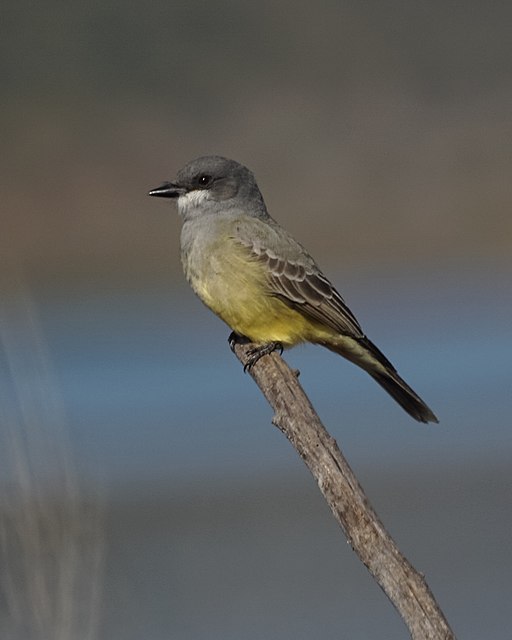Superregnum: Eukaryota
Regnum: Animalia
Subregnum: Eumetazoa
Cladus: Bilateria
Cladus: Nephrozoa
Superphylum: Deuterostomia
Phylum: Chordata
Cladus: Craniata
Subphylum: Vertebrata
Infraphylum: Gnathostomata
Superclassis: Tetrapoda
Cladus: Reptiliomorpha
Cladus: Amniota
Classis: Reptilia
Cladus: Eureptilia
Cladus: Romeriida
Subclassis: Diapsida
Cladus: Sauria
Infraclassis: Archosauromorpha
Cladus: Crurotarsi
Divisio: Archosauria
Subsectio: Ornithodira
Subtaxon: Dinosauromorpha
Cladus: Dinosauria
Ordo: Saurischia
Cladus: Eusaurischia
Cladus: Theropoda
Cladus: Neotheropoda
Infraclassis: Aves
Ordo: Passeriformes
Subordo: Tyranni
Infraordo: Tyrannides
Parvordo: Tyrannida
Familia: Tyrannidae
Subfamilia: Tyranninae
Genus: Tyrannus
Species: Tyrannus vociferans
Subspecies: T. v. vociferans – T. v. xenopterus
Name
Tyrannus vociferans Swainson, 1826
Type locality: Temascaltepec, México, Mexico.
References
Swainson, W.J. 1826. On the Tyrant Shrikes of America. The Quarterly Journal of Science, Literature and the Arts. Royal Institution of Great Britain. London. 20 no.40: 267–285 BHL Reference page. Original description p. 273 BHL
Vernacular names
čeština: Tyran křiklavý
dansk: Nordlig Kongetyran
Deutsch: Cassinkönigstyrann
English: Cassin's Kingbird
español: Tirano gritón
suomi: tarhatyranni
français: Tyran de Cassin
italiano: Tiranno di Cassin
日本語: ハシボソタイランチョウ, hashibosotairanchou
Nederlands: Cassins Koningstiran
norsk: Krattkongetyrann
polski: tyran krzykliwy
русский: Королевский тиранн Кассина
slovenčina: postriežkar krikľavý
svenska: Cassins kungstyrann
中文: 卡氏王霸鹟
Cassin's kingbird (Tyrannus vociferans) is a large tyrant flycatcher native to western North America. The name of this bird commemorates the American ornithologist John Cassin.
Taxonomy
Cassin's kingbird was formally described in 1826 by English naturalist William John Swainson under the current binomial name Tyrannus vociferans. The type locality is Temascaltepec, Mexico.[2][3] The specific epithet vociferans is Latin for "shouting".[4]
Two subspecies are recognised:[5]
T. v. vociferans Swainson, 1826 – southwest USA to central Mexico
T. v. xenopterus Griscom, 1934 – southwest Mexico
Description
Adults have a gray head with slightly darker cheeks; a dark unforked tail with a buffy fringe and gray-olive underparts. They have a pale throat and deep yellow lower breast.
Juveniles are duller and have pale edges on their wings.
Measurements:
Length: 8.3–9.1 in (21–23 cm)[6]
Weight: 1.6 oz (45 g)[6]
Wingspan: 41 cm[7]
Similar species
Comparison of a Cassin's (on the left) and western kingbird
Cassin's kingbird and the western kingbird are similar in appearance. Cassin's is a little larger than the western and the upper parts are a darker gray than the western. The most distinctive difference between these birds is that the Cassin's has a thin white edge along the distal end of the tail feathers, while the western kingbird has a thin white edge that runs along the side of the tail feathers.[8] This difference can be seen in the adjacent image.
Distribution and habitat
U.S. Government lithograph of Cassin's kingbird
In the summer, these birds can be found in California and from Montana to Utah, along the eastern Rocky Mountains. Their habitat includes rangelands and savannas.
These birds migrate to their winter quarters between Southern California and northern Central America. They are permanent residents in south-central Mexico, and their main wintering ranges are west of the Gulf of California on Baja California Sur, and east of the sea on the mainland of western Mexico.
Behavior
They build a bulky nest on a horizontal tree limb in mid-story or the canopy of trees. The three to five spotted white eggs have an incubation period of 18 to 19 days.
The Cassin's kingbird primarily feeds on insects it preys upon from high perches by hawking. It also eats berries and fruits in lesser quantities.
The call is a high-pitched shorter followed by a longer chirp, sounding like chi-beer.
Mating ritual
In early spring, presumably after having chosen (or shown up with) their mate, they launch into a peculiar dance. With excited high-pitched calls, they hover in unison, wings outstretched, over a favorite perch. This dance takes place several times a day over several days, over several separate sites in an area covering 2 to 3 acres (8,100 to 12,100 m2). The sites chosen for the dance appear to be the same sites used as hunting perches during the spring and summer.
References
BirdLife International (2016). "Tyrannus vociferans". IUCN Red List of Threatened Species. 2016: e.T22700491A93779665. doi:10.2305/IUCN.UK.2016-3.RLTS.T22700491A93779665.en. Retrieved 11 November 2021.
Swainson, William John (1826). "On the tyrant strikes of America". Quarterly Journal of Science, Literature and the Arts. 20: 267–285 [273–274].
Traylor, Melvin A. Jr, ed. (1979). Check-List of Birds of the World. Volume 8. Cambridge, Massachusetts: Museum of Comparative Zoology. p. 224.
Jobling, James A. (2010). The Helm Dictionary of Scientific Bird Names. London: Christopher Helm. p. 404. ISBN 978-1-4081-2501-4.
Gill, Frank; Donsker, David; Rasmussen, Pamela, eds. (2020). "Tyrant flycatchers". IOC World Bird List Version 10.2. International Ornithologists' Union. Retrieved 9 October 2020.
"Cassin's Kingbird Identification". All About Birds. Cornell Lab of Ornithology. Retrieved 2020-09-26.
"Cassin's Kingbird". Montana Field Guide. Montana Natural Heritage Program and Montana Fish, Wildlife and Parks. Retrieved 2020-09-26.
The National Geographic Field Guide to the Birds of North America, 4th edition, page 298
Retrieved from "http://en.wikipedia.org/"
All text is available under the terms of the GNU Free Documentation License


